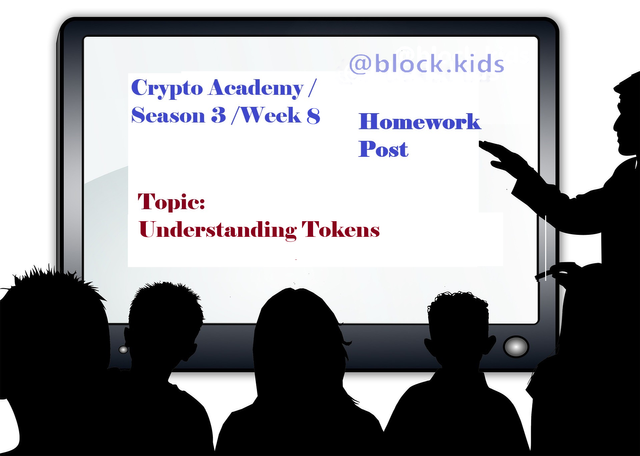Crypto Academy / Season 3 / Week 8 - Homework Post for Professor @reminiscence01 - Topic: Understanding Tokens

Hey, guys!
The 8th week has been a great week so far on the crypto academy community, and it even got more interesting when I got to know about this week's lecture topic ("Understanding Tokens").
As a newbie in cryptocurrencies, I have been confused about how to use some terminologies like tokens, coins, and many more.
However, with the help of professor reminiscence01, I have grasped a better understanding of the difference between a coin and a token.
This homework was done in adequate response to the questions asked in the lecture post on the earlier topic.

Question 1: What do you understand by Token and give an example of at least five tokens and identify the blockchain it is built on. ( give at least three different Blockchains)

According to my newfound understanding, tokens are assets of specific value and function which belong to projects built on any blockchain network. These tokens have various characteristics which allow them to perform a wide array of tasks, including storing value, making investments, executing transactions, and making decisions on their native blockchain network.
However, from my research, I have deduced that one of the significant reasons tokens are usually created is to fund projects on a blockchain network. The method of fundraising involves the use of a standard initial coin offering (ICO) process.
Some examples of these tokens include;
Dai token on the Ethereum blockchain
FTX token on the Binance Smart Chain
BitTorrent on the Tron blockchain
Holo Token on the Ethereum blockchain
UMA token on the Ethereum blockchain
From the few examples above, you will notice more tokens built on the Ethereum blockchain network. This situation is so because over 70%of the total number of tokens are built on the Ethereum blockchain.

Question 2: What is the difference between a token and a coin?


source : Pixabay
Many people use "token" and "coin" interchangeably, although they refer to two concepts in the crypto space.
The difference between a coin and a token is that coins are cryptocurrencies built on their native, standalone and independent blockchain network system. They serve the same purpose as the conventional fiat currency (e.g., US dollars). The primary purpose for the existence of the coins is to store and transfer value.
However, tokens are those cryptocurrencies that do not have a blockchain network of their own. Instead, these cryptocurrencies are built on another blockchain.
Tokens are used to carry out many other functions on the blockchain other than just acting to store or transfer value like the coin.
Tokens are usually distributed through initial coin offerings (ICO), whereas coins are distributed through mining.
Examples of tokens include Basic Attention Token (BAT), DAI, USD Coin (USDC), UMA, and Tether (USDT). In contrast, examples of cons include Bitcoin (BTC), Dogecoin (DOGE), Ripple (XRP), Ethereum (ETH), and Litecoin (LTC).

Question 3: Explain the different categories of tokens listed below and explain its features.
- Utility tokens
- Security tokens
- Equity tokens
- Non-fungible Token (NFT)

Utility tokens
Utility tokens are those tokens that enable users to gain access to a particular service or product. These tokens are usually issued by Developers to the users through an ICO to raise funds for launching a project. For example, the Basic Attention Token (BAT) allows users to access a particular level of services on the brave browser.
In addition, the utility token also gives the user a voting right which enables that user participate in deciding developments in the project launched by the developers
Other examples of utility tokens include Funfair, FIL token, Brickblock, Timicoin, Sirin Labs Token, and Golem.
Security tokens
Security tokens can be regarded as proof of investment in a project, company, or assets such as equities and fixed income. Even as security token holders are entitled to a share of profits in the asset, they also get voting right in decision-making. Security tokens are rare because Developers issue security tokens only during Security Token Offering (STO), and every security token is registered to an owner. One good example of a security token is Uniswap which is trading a real estate property from RealT.
Equity tokens
Equity tokens or Asset tokens are pretty similar to security tokens because This also Token depicts ownership gives the holder a voting right to participate in decision-making concerning developments in the invested projects.
However, it is different because equity tokens are linked to real-world assets such as real estate, silver, bonds, shares, gold, etc. The Equity token is an actual representation of an equivalent real-world investment. Companies in recent times create equity tokens to represent shares held by shareholders of that company. An excellent example of an Equity token is the Slice token, a commercial real estate (CRE) investment platform.
Non-fungible tokens (NFTs)
Non-fungible tokens are tokens that represent a wide variety of unique items which have significant value
These items could be either natural or virtual. In other words, these items range from a digital picture to coins and special rewards in a game. All NFTs are unique and, therefore, cannot be interchangeable. Other examples of NFTs include unique digital artwork, a unique sneaker in a limited-run fashion line, an essay, a digital collectible, a domain name.

Question 4: Do your research and write extensively on any token you listed in question one. (Must include features of the Token, the aim of the project, Use cases).


source : Coin Bureau
The Universal Market Access Protocol uses a token called the UMA token. According to my previous research, the UMA token was distributed to its users through an initial Dex Offering ( IDO ) launched on the Uniswap platform.
The UMA protocol's main aim was to allow DeFi developers to produce tokens on the Ethereum network that can track the prices of assets. While the main objective of the UMA token was to represent the voting right(status) of users on UMA protocol Improvement Proposals. Consider a case where a user who has only 2 UMA and can vote as part of the active governance participants on a particular system upgrade on the UMA protocol. If that user votes with the majority, he will receive a certain amount of UMA tokens as a reward for being part of the users who decided the most preferred course of action on UMA protocol. The users will now own more than two UMA tokens and have more voting rights in the play form.

source : Screenshot from Coingecko
The screenshot above shows that as of this post, the UMA token was ranked at #119 with a price of $12.32. The total supply of UMA is a little over 100 million tokens
The features of the UMA token includes ;
They are enabling users to track the prices of everything they want.
The ability to grant Users on the UMA protocol a voting right.
Being decentralized as it is built on the Ethereum blockchain network
-It is tradable and can be exchanged with other tokens on the Ethereum blockchain network.
The UMA protocol is used in two different ways;
The priceless financial contract: DeFi developers can develop tokens that can benefit without any on-chain price feed. An example of this is Ethereum (ERC-20)
UMA Oracle Design: The UMA Oracle is used in reporting all off-chain data to the Ethereum network.
However, the principal purpose of the UMA protocol is to connect traditional financial traders with the benefits from technology and the developers of DeFi.

Conclusion

Understanding the terminologies used in any field is very important as it enables a person to process information efficiently.
As explained in the content above, a coin differs from a token in many ways, even though it can store and transfer value.
There are many types of tokens, and each type performs various functions. This week's activity has helped broaden my knowledge about Cryptocurrencies in general, and that is all thanks to the crypto academy and professor reminiscence01.
Hello @block.kids, I’m glad you participated in the 8th week of the Beginner’s class at the Steemit Crypto Academy. Your grades in this task are as follows:
Recommendation / Feedback:
Thank you for completing this homework task.